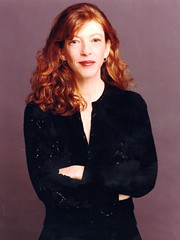
Susan Orlean has written for Rolling Stone, Vogue and Esquire. She has been a staff writer at the New Yorker since 1992 and has published two collections of her work for the magazine: 2001’s The Bullfighter Checks Her Makeup: My Encounters with Extraordinary People and 2004’s My Kind of Place: Travel Stories from a Woman Who’s Been Everywhere. However, she is probably best-known as the fictionalized version of herself played by Meryl Streep in Adaptation, Spike Jonze/Charlie Kaufman’s transmogrification her 1998 bestseller The Orchid Thief. She will be appearing at the Free Library tomorrow night to promote her latest book Rin Tin Tin: The Life And The Legend which is s much more than just the unauthorized biography of a show biz dog, it’s also, well, we’ll let her explain…
PHAWKER: What is the best thing about being portrayed by Meryl Streep in Adaptation? What was the worst?
SUSAN ORLEAN: The worst has been being asked constantly what it was like to be portrayed by Meryl Streep in Adaptation and whether she got my accent  right. The best was being portrayed on screen by Meryl Streep and not by, say, Kim Kardashian.
right. The best was being portrayed on screen by Meryl Streep and not by, say, Kim Kardashian.
PHAWKER: In 1999 you wrote a book under your married name Susan Sistrom called What Every Skinny Woman Knows About Dieting (And Won’t Tell You). Can you give us a few hints? Chain-smoking? Bulimia? Meth addiction?
SUSAN ORLEAN: Meth would be my fast-track advice. Otherwise, I’d suggest not having that second helping of fried Oreos at the county fair; one helping, maybe. Or have the second helping and then run a marathon.
PHAWKER: A collection of your New Yorker stories is called My Kind of Place: Travel Stories from a Woman Who’s Been Everywhere. Favorite place on Earth and why? Least favorite and why?
SUSAN ORLEAN:My favorite place is Bhutan, which is almost unbelievably beautiful and has been miraculously spared most of the ugly impact of tourism and Westernization. And those Himalayas are really pretty. Least favorite is harder to pick. I’ve never been anywhere that didn’t have some redeeming quality, but I wouldn’t choose to vacation at Mall of America.
PHAWKER: By way of advice for aspiring writers. If you want write for the New Yorker you should _____.
SUSAN ORLEAN:Be a good typist.
PHAWKER: Barring the freakishly animal-obsessed, why would the average person on the street read what amounts to the biography of a dog?
 SUSAN ORLEAN:They should read it because it’s also the history of Hollywood, of American popular culture over the last hundred years, of the role dogs have played in social history. And it’s a love story about the individuals who were devoted to Rin Tin Tin and his legacy — in fact, it’s really more a book about those people than about the dog himself.
SUSAN ORLEAN:They should read it because it’s also the history of Hollywood, of American popular culture over the last hundred years, of the role dogs have played in social history. And it’s a love story about the individuals who were devoted to Rin Tin Tin and his legacy — in fact, it’s really more a book about those people than about the dog himself.
PHAWKER: Why Rin Tin Tin and not Lassie?
SUSAN ORLEAN:Easy: Because Lassie wasn’t a real dog. Lassie was a character in a book and then a character in movies and television. Rin Tin Tin’s story is much more complex — he was a puppy found in WWI who became a global star in the 1920s and then an American icon in the 1930s and then a television sensation in the 1950s and 1960s. On top of that, the history of German shepherds is fascinating, touching on everything from Nazi Germany to the US Army to the civil rights movement. Collies are lovely. But they aren’t a great story.
